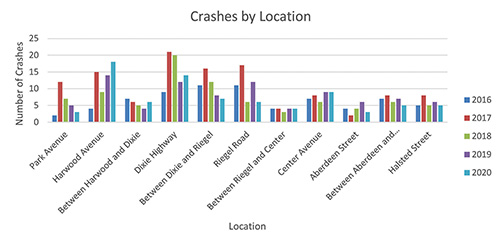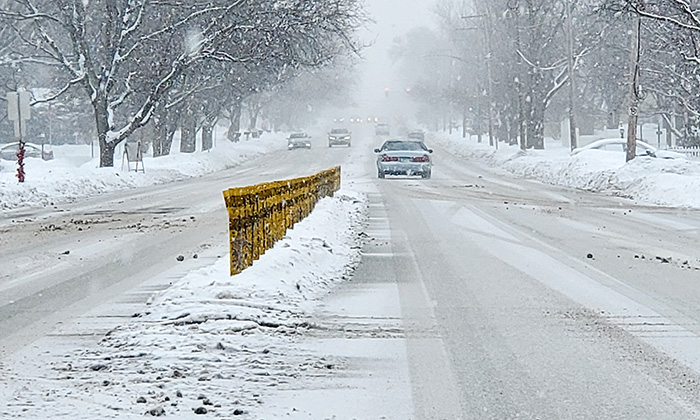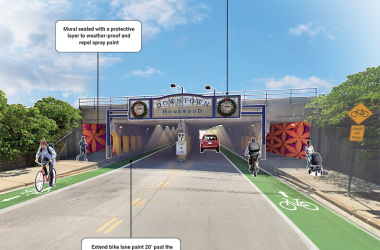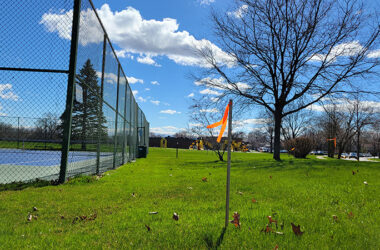
A study examining 183rd Street traffic patterns and ways to address safety concerns of Homewood trustees and residents was presented at the Nov. 9 regular board meeting.
The study was presented by Stephen Boden and Stephen Crede from Burns and McDonnell, a firm hired by the village to offer ways to make the street safer. The two discussed the scope of the study, findings to date, next steps and addressed questions.
The study effort was sparked by a crash near the intersection of 183rd Street and Center Avenue in 2020 that killed a Merrillville 19-year-old. Since then, residents have petitioned the village to take action on speeding and other dangerous traffic behavior.
Boden said the study looked at 183rd Street from Park Avenue on the west to Halsted Street on the east, which is a distance of 1.83 miles. The study includes traffic counts, crash analysis and traffic modeling. It also contains potential solutions and recommendations.
On April 13, 2021, the firm collected data on traffic counts every 15 minutes at seven major intersections on 183rd Street. According to the study, there were higher traffic volumes west of Dixie Highway compared to eastbound. It also found that there are consistent traffic volumes throughout the day with no significant morning or evening rush hour surges. That makes the street unusual, Boden said.
“You have a peak in the morning but as your midday goes on you actually have another peak and you get to a higher volume,” Boden said. “And in the evening, you have another peak as well. Usually streets have a morning peak, they go down in the afternoon and then they go up in the evening.”
Crede went on to discuss the crash analysis conducted for the study, which included examining 428 crash reports from 2016 to 2020. The firm looked at each individual crash, where it took place, circumstances surrounding the crash and the mitigating factors that could have contributed. He said over 40% of reported crashes occurred between Park Avenue and Dixie Highway. The Dixie Highway intersection had the most crashes, with a total of 76. Crede said a finding of particular interest was that 76% of the crashes happened during dry, daytime conditions.
“We really did not see weather or time of day playing a significant factor in the crashes taking place,” he said.
The firm also called attention to the total number of crashes resulting in injuries typically requiring ambulance transport and evident injuries treated on scene on Center Avenue, Crede said. That corridor marked the highest frequency of severe crashes. Some of the causes contributing to that include poor sight distance on opposing left turns, crossing movements or poor geometry, and driver error such as ignoring stop signs, driving the wrong way on the road or making illegal U-turns.
In 2020, delineators were installed on the center line of 183rd Street, accompanied by no left turn signs on Center. It is intended to eliminate left turns and northbound and southbound movements.
Those measures should have been successful “if people had followed the roadway directions they were given,” Crede said. “However people making decisions in their own best interests have led to some of the issues we’ve seen.”
Crede presented possible solutions to mitigate some of the roadway’s challenges, including making that intersection a four-way stop, implementing a permanent traffic signal or a temporary traffic signal and extending a barrier median.
The study also includes potential solutions for other locations along 183rd Street. They are ranked in the study based on importance, the number of accidents that occured there and their severity. Each solution contains a feasibility ranking, an estimated project cost and whether more study is needed.
What the list of solutions does not contain is an analysis of how each one could create unintended consequences. That’s something that would be pursued in the next step of the process, Crede said.
One of the next steps in the process is finding funding for some of the proposed solutions. Crede said some could be funded by the village due to how inexpensive they are, while others may prompt the village to consider federal funds to help foot the bill. In the latter scenario, the village will need to make sure it’s conforming to National Environmental Protection Act procedures by creating a project development report, including environmental studies and the firm’s formal traffic and crash study. The Illinois Department of Transportation’s (IDOT) Federal Highway Administration Joint Review Committee would need to review a presentation of the village’s proposal. Design approval would also need to be granted by IDOT District 1.
“Once we know what potential solutions you want to move forward with, then we can start looking for the most applicable funding sources, so we know who we start applying to. That’ll be something we want to do as quickly as possible so we can get those out there and start finding money for the village where possible,” Crede said.
Crede said IDIOT’s involvement would make the process longer but it could be in exchange for about 80% of project costs.
After the presentation concluded, residents had a chance to ask questions, make comments, offer suggestions and voice their concerns. One resident who lives on Park Avenue wondered whether surveillance cameras would help mitigate problems where Park dead-end’s at 183rd Street. Only right turns are allowed, but drivers routinely make left turns. John Schaefer, director of Public Works, said one possible solution would be a more permanent measure to eliminate left hand turns. Schaefer said according to state law, implementing cameras and issuing tickets isn’t allowed.
The resident also pointed out that a number of trucks going south on Park Avenue make the illegal left hand turn onto 183rd Street. He suggested a no left turn sign be put up at the entrance of Park Avenue. Hofeld said the resident made a good point and directed Schaefer to look into putting up signage by the north viaduct.
Another resident noted that there was only one mention of speeding on page 156.
“The reason why the fatality at 183rd and Center occurred was speeding,” he said, noting the report also doesn’t address adjusting the average speed throughout the village. He suggested putting a police squad car along Dixie Highway.
“If you can reduce the speed you’re going to reduce the seriousness of the accidents,” he added.
To his point, Police Chief Denise McGrath said traffic enforcement is a large part of every officer’s day. However, being in a marked squad deters people from speeding. She said the village has seen an increase in speeding coming out of the COVID-19 pandemic, as is the case statewide and nationwide.
“We are doing as much as we can to prevent it as far as enforcement,” she said, noting the department is increasing traffic stops and gearing up to perform target traffic enforcement with new officers coming onto the force.
“It’s as much of our concern as it is your concerns and I think if we all work together, we can help resolve some of these issues and encourage our neighbors and our friends to be more cognizant of their driving,” the chief said.
One resident who lives on the corner of 183rd and Center said she sees drivers frequently making illegal U-turns around the barriers. She believes many drivers may not know that move is illegal, but signage could help.

Trustee Lisa Purcell said that idea is a good one and that the study contains a lot of good ideas. She said the board should add more ideas to address speeding, while acknowledging some of the solutions could also contribute to speeding.
Crede said some of the solutions aim to address speed by creating “a level of discomfort” for drivers.
“For instance, when you narrow a lane, that subconsciously makes people uncomfortable because they no longer feel like they have space,” he said. “The tighter you make it on them, the slower they tend to drive because they’re more uncomfortable.”
Trustee Lauren Roman said she was happy to hear there were more police officers that will be helping out with enforcement and that she also loves the idea about the no U-turn sign.
“Maybe that’s something we can have done sooner rather than later,” she said.
There are solutions the village could put in place now to address some of the 183rd Street issues, Hofeld said. They include putting a median on Park Avenue, putting signage at the north viaduct that says no left turns at 183rd Street and implementing “no U-turn” signs.
He said staff will look at the proposed solutions and come back to the board with the best recommendations and the cost estimates.



